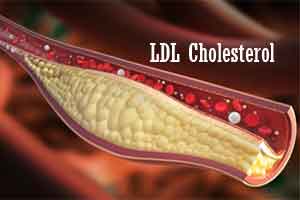- Home
- Editorial
- News
- Practice Guidelines
- Anesthesiology Guidelines
- Cancer Guidelines
- Cardiac Sciences Guidelines
- Critical Care Guidelines
- Dentistry Guidelines
- Dermatology Guidelines
- Diabetes and Endo Guidelines
- Diagnostics Guidelines
- ENT Guidelines
- Featured Practice Guidelines
- Gastroenterology Guidelines
- Geriatrics Guidelines
- Medicine Guidelines
- Nephrology Guidelines
- Neurosciences Guidelines
- Obs and Gynae Guidelines
- Ophthalmology Guidelines
- Orthopaedics Guidelines
- Paediatrics Guidelines
- Psychiatry Guidelines
- Pulmonology Guidelines
- Radiology Guidelines
- Surgery Guidelines
- Urology Guidelines
LDL levels above 160 tied to CVD mortality even in low risk patients

LDL (low-density lipoprotein) levels above 160 mg/dL in the patients otherwise deemed at low risk for cardiovascular disease (CVD) face a 50% to 80% increased relative risk of CVD mortality over the long term. Findings, published in the journal Circulation may have implications for future cholesterol treatment paradigms.
The associations of low-density lipoprotein cholesterol (LDL-C) with CVD and coronary heart disease mortality in an exclusively low estimated 10-year risk group are not well delineated.
Shuaib M. Abdullah, Department of Internal Medicine, University of Texas Southwestern Medical Center, Dallas, and colleagues conducted the study to determine the long-term associations of various LDL-C and non–high-density lipoprotein cholesterol (HDL-C) thresholds and CVD and coronary heart disease mortality in a large, low 10-year risk cohort.
For the study, the research team measured lipid levels of over 36,000 adults in Texas (median age, 42) with an estimated 10-year risk for atherosclerotic CVD events below 7.5%, and followed for a median of 27 years.
Also Read: Lower the LDL cholesterol level, lower is the risk to heart : JAMA
Key Results:
- About 1086 CVD and 598 coronary heart disease deaths occurred.
- Compared with LDL-C <100 mg/dL, LDL-C categories 100 to 129 mg/dL, 130 to 159 mg/dL, 160 to 189.9 mg/dL, and ≥190 mg/dL were associated with a significantly higher risk of CVD death, with hazard ratios of, and mean reductions in years free of CVD death of 1.8, 1.1, 4.3, and 3.9, respectively.
- After adjustment for atherosclerotic CVD risk factors, LDL-C categories 160 to 189 mg/dL and ≥190 mg/dL remained independently associated with CVD mortality, with hazard ratios of 1.7 (95% CI, 1.4–2.2) and 1.5 (95% CI, 1.2–2.1), respectively.
- In multivariable-adjusted models using non–HDL-C <130 mg/dL as the reference, non–HDL-C 160 to 189 mg/dL, 190 to 219 mg/dL, and ≥220 mg/dL were significantly associated with CVD death, with hazard ratios of 1.3 (95% CI, 1.1–1.6), 1.8 (95% CI, 1.4–2.2), and 1.5 (95% CI, 1.2–2.0), respectively.
- Restricting the cohort to those with 10-year risk <5% did not diminish the associations of LDL-C and non–HDL-C with CVD mortality.
The researchers note that 2013 cholesterol guidelines recommend statins for low-risk patients when LDL reaches 190 mg/dL, with a class IIb recommendation for considering treatment at 160 mg/dL. They say their current findings "suggest a stronger consideration of using the LDL-C ≥160 mg/dL cutoff."
For more information log on to https://doi.org/10.1161/CIRCULATIONAHA.118.034273

Disclaimer: This site is primarily intended for healthcare professionals. Any content/information on this website does not replace the advice of medical and/or health professionals and should not be construed as medical/diagnostic advice/endorsement or prescription. Use of this site is subject to our terms of use, privacy policy, advertisement policy. © 2020 Minerva Medical Treatment Pvt Ltd